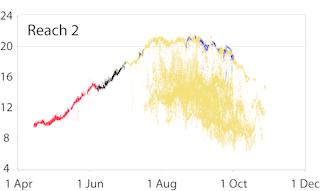PLOS ONE ( IF 3.7 ) Pub Date : 2018-09-21 , DOI: 10.1371/journal.pone.0204274 Matthew L. Keefer , Tami S. Clabough , Michael A. Jepson , Eric L. Johnson , Christopher A. Peery , Christopher C. Caudill

|
Rising river temperatures in western North America have increased the energetic costs of migration and the risk of premature mortality in many Pacific salmon (Oncorhynchus spp.) populations. Predicting and managing risks for these populations requires data on acute and cumulative thermal exposure, the spatio-temporal distribution of adverse conditions, and the potentially mitigating effects of cool-water refuges. In this study, we paired radiotelemetry with archival temperature loggers to construct continuous, spatially-explicit thermal histories for 212 adult Chinook salmon (O. tshawytscha) and 200 adult steelhead (O. mykiss). The fish amassed ~500,000 temperature records (30-min intervals) while migrating through 470 kilometers of the Columbia and Snake rivers en route to spawning sites in Idaho, Oregon, and Washington. Spring- and most summer-run Chinook salmon migrated before river temperatures reached annual highs; their body temperatures closely matched ambient temperatures and most had thermal maxima in the lower Snake River. In contrast, many individual fall-run Chinook salmon and most steelhead had maxima near thermal tolerance limits (20–22 °C) in the lower Columbia River. High temperatures elicited extensive use of thermal refuges near tributary confluences, where body temperatures were ~2–10 °C cooler than the adjacent migration corridor. Many steelhead used refuges for weeks or more whereas salmon use was typically hours to days, reflecting differences in spawn timing. Almost no refuge use was detected in a ~260-km reach where a thermal migration barrier may more frequently develop in future warmer years. Within population, cumulative thermal exposure was strongly positively correlated (0.88 ≤ r ≤ 0.98) with migration duration and inconsistently associated (-0.28 ≤ r ≤ 0.09) with migration date. All four populations have likely experienced historically high mean and maximum temperatures in recent years. Expected responses include population-specific shifts in migration phenology, increased reliance on patchily-distributed thermal refuges, and natural selection favoring temperature-tolerant phenotypes.
中文翻译:

成年奇努克鲑鱼和硬头鱼的热暴露:在一个大型且变暖的河流系统中的多种行为策略
北美西部河流温度的升高增加了迁移的能源成本,并增加了许多太平洋鲑鱼(Oncorhynchus spp。)种群过早死亡的风险。要预测和管理这些人群的风险,需要有关急性和累积热暴露,不利条件的时空分布以及凉水避难所的潜在缓解作用的数据。在这项研究中,我们搭配存档温度记录器遥测构建连续的,空间上明确的热历史对212成人大鳞大麻哈鱼(ø。tshawytscha)和200成人虹鳟(Ò。虹鳟)。鱼聚敛〜500000条温度记录(30分钟间隔),同时通过哥伦比亚和蛇河流470公里迁移途中到爱达荷州,俄勒冈州和华盛顿州的产卵场。春季和大部分夏季运行的奇努克鲑鱼在河水温度达到年度最高值之前就已经迁移了。它们的体温与环境温度非常接近,大多数在斯内克河下游具有最高的热量。相反,在哥伦比亚河下游,许多秋季落成的奇努克鲑鱼和大多数硬头鲑在热耐受极限(20–22°C)附近具有最大值。高温导致在支流汇合处附近广泛使用热避难所,那里的体温比邻近的迁移走廊低约2-10°C。许多硬头鱼使用避难所长达数周或更长时间,而鲑鱼的使用通常需要数小时至数天,这反映了产卵时间的差异。在约260公里的范围内,几乎未发现任何避难所,在未来的较暖年份中,热迁移壁垒可能会更加频繁地形成。在人群中,累积的热暴露与正相关性极强(0.88≤ř与迁移的持续时间和相关联的不一致(-0.28≤≤0.98)- [R与迁移日期≤0.09)。近年来,这四个人口的平均气温和最高气温都可能达到历史最高水平。预期的响应包括迁移物候方面的特定于人群的变化,对零散分布的避难所的依赖性增加以及有利于温度耐受表型的自然选择。



























 京公网安备 11010802027423号
京公网安备 11010802027423号